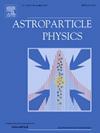Identification of gamma ray pulsar candidates in the Fermi-LAT 4FGL-DR4 unassociated sources using supervised machine learning
IF 2.9
3区 物理与天体物理
Q1 ASTRONOMY & ASTROPHYSICS
引用次数: 0
Abstract
The Large Area Telescope (LAT) on board the Fermi Gamma-ray Space Telescope has been continuously providing good quality survey data of the entire sky in the high energy range from 30 MeV to 500 GeV and above since August 2008. A succession of gamma-ray source catalogs is published after a comprehensive analysis of the Fermi–LAT data. The most recent release of data in the fourth Fermi–LAT catalog of gamma-ray sources (4FGL-DR4), based on the first 14 years of observations in the energy band 50 MeV- 1 TeV, contains 7195 sources. A large fraction ( 33%) of this population has no known counterparts in the lower wave bands. Such high energy gamma-ray sources are referred to as unassociated or unidentified. An appropriate classification of these objects into known type of gamma-ray sources such as the active galactic nuclei or pulsars is essential for population studies and pointed multi-wavelength observations to probe the radiative processes. In this work, we perform a detailed classification of the unassociated sources reported in the 4FGL-DR4 catalog using two supervised machine learning techniques- Random Forest and Extreme Gradient Boosting. We mainly focus on the identification of new gamma-ray pulsar candidates by making use of different observational features derived from the long-term observations with the Fermi–LAT and reported in the incremental 4FGL-DR4 catalog. We also explore the effects of data balancing approach on the classification of the Fermi–LAT unassociated sources.
使用监督机器学习识别Fermi-LAT 4FGL-DR4非相关源中的伽马射线脉冲星候选者
自2008年8月以来,费米伽玛射线空间望远镜上的大面积望远镜(LAT)一直在持续提供30 MeV至500 GeV及以上高能范围内的全天空高质量巡天数据。在对费米- lat数据进行全面分析后,一系列伽玛射线源目录被公布。最新发布的Fermi-LAT第四次伽玛射线源目录(4FGL-DR4)数据,基于前14年在50 MeV- 1 TeV波段的观测,包含7195个源。这一群体的很大一部分(约33%)在较低的波段没有已知的对应物。这种高能伽玛射线源被称为不相关的或未识别的。将这些天体适当分类为已知类型的伽玛射线源,如活动星系核或脉冲星,对于种群研究和探测辐射过程的多波长定点观测至关重要。在这项工作中,我们使用两种监督机器学习技术(随机森林和极端梯度增强)对4FGL-DR4目录中报告的不相关源进行了详细分类。我们主要利用Fermi-LAT长期观测和4FGL-DR4增量目录中报告的不同观测特征来识别新的伽玛射线脉冲星候选者。我们还探讨了数据平衡方法对费米- lat非相关源分类的影响。
本文章由计算机程序翻译,如有差异,请以英文原文为准。
求助全文
约1分钟内获得全文
求助全文
来源期刊

Astroparticle Physics
地学天文-天文与天体物理
CiteScore
8.00
自引率
2.90%
发文量
41
审稿时长
79 days
期刊介绍:
Astroparticle Physics publishes experimental and theoretical research papers in the interacting fields of Cosmic Ray Physics, Astronomy and Astrophysics, Cosmology and Particle Physics focusing on new developments in the following areas: High-energy cosmic-ray physics and astrophysics; Particle cosmology; Particle astrophysics; Related astrophysics: supernova, AGN, cosmic abundances, dark matter etc.; Gravitational waves; High-energy, VHE and UHE gamma-ray astronomy; High- and low-energy neutrino astronomy; Instrumentation and detector developments related to the above-mentioned fields.
 求助内容:
求助内容: 应助结果提醒方式:
应助结果提醒方式:


